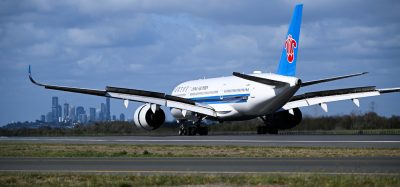Navigating storms
- Like
- Digg
- Del
- Tumblr
- VKontakte
- Buffer
- Love This
- Odnoklassniki
- Meneame
- Blogger
- Amazon
- Yahoo Mail
- Gmail
- AOL
- Newsvine
- HackerNews
- Evernote
- MySpace
- Mail.ru
- Viadeo
- Line
- Comments
- Yummly
- SMS
- Viber
- Telegram
- Subscribe
- Skype
- Facebook Messenger
- Kakao
- LiveJournal
- Yammer
- Edgar
- Fintel
- Mix
- Instapaper
- Copy Link
Posted: 25 November 2005 | John P. Heimlich, Vice President and Chief Economist, ATA | No comments yet
In this article, John Heimlich presents his viewpoint on the economic pressures currently affecting the aviation industry in North America.
In this article, John Heimlich presents his viewpoint on the economic pressures currently affecting the aviation industry in North America.
On August 17, 2005, with Hurricane Katrina approaching the Gulf Coast of the United States, the price of jet fuel stood at US$ 1.87 per gallon. At 42 gallons per barrel, that per-gallon price translated to US$ 78.69 per barrel – US$ 15.40 higher than the price of crude oil. Well before Katrina approached, U.S. airlines were battling high prices and fuel supply constraints across the system, as global departures surged and an outdated infrastructure limited the injection and movement of Jet A into U.S. airports.
Katrina landed ashore on August 29. By September 1, jet fuel prices (Average of New York Harbor, U.S. Gulf Coast, and Los Angeles jet fuel spot prices from the U.S. Energy Information Administration) had risen 49 cents per gallon to US$ 2.36, or US$ 99.13 per barrel – US$ 29.63 above the price of crude oil. That product-to-crude gap is known as the ‘crack spread’, essentially the refining profit margin. As of September 7, thanks to recovery efforts and some quick action by various federal agencies, the price of jet fuel had fallen to US$ 2.08 per gallon or US$ 87.51 per barrel. The crack spread had narrowed to a still-high US$ 23.13 per barrel.
Hurricane effects
In my ‘side’ role as the coordinator of the Air Transport Association of America (ATA) Fuel Committee, on August 30 I began receiving calls from passenger and cargo airlines deeply concerned about the toll Katrina had taken on pipelines and refineries in the Gulf. To put things in perspective, consider that U.S. refineries produce 1.55 million barrels of jet fuel on a daily basis. Katrina eliminated about 13 percent – nearly 200,000 barrels – of daily production. I suggested that we should convene an industry supply-and-logistics call that very afternoon. And with that, an emergency process was born that we would expand and improve upon through two more hurricanes.
ATA, in coordination with IATA, the Regional Airline Association and Cargo Airline Association convened multiple emergency fuel supply-and-logistics conference calls post-Hurricane Katrina to assist carriers in maintaining adequate fuel supplies at U.S. airports. These were used to post daily fuel inventories and forecasts on its restricted Fuel Committee Web site, to serve as the clearinghouse for tankering recommendations and supply updates, and to pursue federal policy actions that could alleviate the supply crisis.
To that end, ATA successfully pursued a coordinated release of the Strategic Petroleum Reserve and the International Energy Agency stock release, combining for two million barrels a day of crude oil and refined product to be released or loaned over a 30-day period.
More hurricanes
Then came Rita. As of September 29, a barrel of jet fuel cost $109.06, versus $66.83 for crude oil – up 123 percent and 59 percent respectively from the beginning of the year. As of October 15, a barrel of jet cost an average of $95.20, with prices in the Gulf Coast as high as $107.86.
As of September 30, according to the U.S. Department of Energy (DOE), four refineries remained closed in the New Orleans area from Katrina, seven in the Port Arthur and Lake Charles areas, and one closed or attempting to restart in the Houston/Texas City/Galveston refining area. This amounted to a total of more than three million barrels per day of refining capacity offline. So combined, post-Katrina and post-Rita, nearly 400,000 barrels per day of jet fuel were not being produced, representing roughly 25 percent of normal US jet fuel production.
Again, ATA convened conference calls to assist in maintaining adequate fuel supplies at U.S. and later Mexican, airports. ATA also co-led an industry-wide call with the U.S. Departments of Energy and Transportation (DOT) to expedite the resumption of refineries and other facilities in the Gulf region.
Then came Wilma, which disrupted power at a number of South Florida airports. When Wilma hit, fuel supplies were reaching critical levels at certain West Coast locations such as San Diego (SAN). At the direction of its member airlines, and fuel consortia chairs in particular, ATA posted ‘do-not-tanker’ recommendations on its site for numerous western locations and disseminated information to assist with the restoration of fuel supplies.
To help avert or mitigate future supply crises, the ATA Fuel Committee has since designated a task force of airline fuel representatives to devise possible means of providing economic incentives to consortia members to reduce uplifts or increase local supply when the chips are down.
Industry consolidation
Taking a step back from the supply crisis itself, it’s my view that high jet fuel prices, particularly in an era of limited pricing power, are the primary driver today of airline industry consolidation. US Airways-America West and a number of smaller liquidations are examples. In total, U.S. passenger and cargo airlines are projected to consume more than 19 billion gallons of jet fuel in worldwide operations in 2005. Thanks to improved fuel efficiency, that figure remains below the 2000 peak of 20.3 billion gallons. And keep in mind that airlines need little incentive to improve jet fuel efficiency, because unlike other modes of transport they have no alternative source of energy. At a consumption rate of 19 billion gallons per year, every penny increase in the price of a gallon of jet fuel drives an additional $190 million in annual fuel costs for U.S. airlines. So if the price were a dollar higher over the course of a year, we’re talking about a $19 billion increase in expenses.
Consider how higher fuel prices affect an individual flight. As cited in a September 12 Bear Stearns research report, “It costs an airline over $12,000 in fuel alone to fly a [Boeing] 757 from L.A. to New York, which means that flying coast-to-coast is over $4,000 more expensive per trip today than it was in 2004.” Just two days later, the Washington Post quoted Independence Air’s Jeff Pollack as follows: “Flying to L.A. burns a lot of fuel, and we’re not seeing average fares that cover that. We burn about 3,500 gallons on a trip to the West Coast, and since fuel is up by a dollar in recent months, that’s another $3,500 per trip we needc to recoup. The current fares people are willing to pay to the West Coast just aren’t able to cover the expense of flying there.”
Thanks to the high price of crude as well as a range of issues with refining capacity, product distribution, and market speculation, jet fuel prices have soared. Even before Hurricane Rita landed, we saw two additional bankruptcy filings, not to mention significant reductions in domestic air service. Others may be on the horizon.
Traditionally, airlines have ‘hedged’ a portion of their fuel requirements by locking in future purchases at a set price. However, hedging is a gamble, rather than an arbitrage opportunity, and it requires a relatively healthy financial condition (i.e., investment-grade credit), a willing counter-party, and often a hefty up-front transaction cost. In a period with abysmal credit ratings, it’s near impossible to secure a good deal for many carriers. Some carriers had to liquidate hedges either in the course of filing for bankruptcy protection or to free up cash to meet immediate financial obligations. No airline out there is 100 percent hedged and no industry in America foresaw oil prices in excess of $50 per barrel at this point, let alone $70.
Optimisation efforts
To combat soaring fuel prices, airlines have developed many different operational and planning techniques aimed at saving fuel and optimising fuel purchases. On the operational front, airlines are employing single-engine taxi during normal operations and selective engine shutdown during ground delays; reducing and measuring more accurately onboard weight and redistributing belly cargo; tankering extra fuel on certain flights to avoid refuelling at more expensive locations, and cruising at higher altitudes and employing shorter, steeper approaches.
In terms of planning for fuel usage, airlines are optimising flight planning for minimum fuel-burn routes and altitudes; working with the FAA to change en-route fuel reserve requirements; working to reduce airborne holding; modernising their fleets with more fuel-efficient airplanes; investing in winglets to increase fuel conservation; redesigning hubs and schedules to alleviate congestion; advocating expanded and improved airfield capacity; using airport power rather than onboard auxiliary power units when at the gates; changing paint schemes to minimise heat absorption; altering the location in which fuel is purchased, and pooling resources to purchase fuel in bulk through alliances with other carriers. Consider that Air Canada is contemplating stripping the paint from its fleet of Boeing 767s to conserve up to one million Canadian dollars annually!
Thanks to efforts such as these since 2000, the average airline fuel efficiency for U.S. passenger airlines has risen to an impressive 18.1 percent average, from 38.2 revenue passenger-miles (RPMs) per gallon to 45.1. Of course, part of that gain is driven by higher passenger load factors. If we look strictly at capacity per gallon, we find a 12.1 percent increase over that same period, from 52.8 to 59.0 available seat-miles (ASMs) per gallon. Viewed over a longer time span, it is worth noting that U.S. airlines have tripled passenger-miles flown per gallon since our first data point in 1971. ASMs per gallon doubled over that period.
In the end, supply tightness has become a growing commercial challenge and frustration at a number of airports, quite obviously exacerbated by Hurricanes Katrina and Rita, which collectively wiped out 25 percent of our daily jet fuel production through damage to Gulf Coast refineries and pipelines. That doesn’t mean airlines have been forced to cancel flights, but the logistics required to maintain adequate jet fuel supplies nationwide are unprecedented. Indeed, fuel supply tightness has effectively become a way of life for carriers today. Also, this comes at a time when demand for automobile/truck gasoline and diesel are high. The hurricanes and other weather that affected refineries worsened an already difficult situation.
At least for the time being, thanks to the extraordinary efforts of and cooperation amongst airlines, ground service providers and fuel suppliers in managing the supply tightness, flights continue as scheduled. By securing off-site storage, tankering fuel, or supplementing pipeline-transported supplies with shipments by land or sea, they’ve managed to keep passengers and shippers from experiencing palpable disruption. This industry is quite familiar with working fuel-supply issues simultaneously, and that experience is clearly paying off.
John Heimlich
John Heimlich was named chief economist in October 2003 and appointed vice president in December 2004. Prior to joining ATA in 2001, Heimlich spent five years at United Airlines, where he worked in the financial planning, financial analysis and international and regulatory affairs departments. He worked as a consultant on environmental programs for American Management Systems in Washington, D.C., from 1991 to 1994.

















